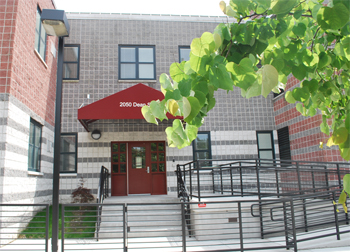A First in NY: Residence for Young Offenders with Mental Illness
 Last week marked the opening of the first psychiatric residence for juvenile delinquents in the state's custody. Most of the handful of young people who have moved into the new home in Brooklyn are transferring from juvenile justice facilities upstate. Some have been waiting for weeks or even months to move in, says Michael Pawel, who runs the August Aichhorn Center, which operates the new residence.
These young people are among the 50 percent of young adults in state-run juvenile correctional facilities who have been diagnosed with a mental illness, according to the Office of Children and Family Services (OCFS), which runs the New York State juvenile justice system. Child Welfare Watch has previously reported on how difficult it is to find appropriate placements for court-involved youth with mental illness. A 2009 federal Department of Justice investigation found that state-run juvenile justice facilities were woefully lacking in the treatment of mental illness. As we reported in 2009, state-licensed residential treatment facilities, which are designed to work with mentally ill young people, are notorious for screening out children known to be aggressive or violent.
Last week marked the opening of the first psychiatric residence for juvenile delinquents in the state's custody. Most of the handful of young people who have moved into the new home in Brooklyn are transferring from juvenile justice facilities upstate. Some have been waiting for weeks or even months to move in, says Michael Pawel, who runs the August Aichhorn Center, which operates the new residence.
These young people are among the 50 percent of young adults in state-run juvenile correctional facilities who have been diagnosed with a mental illness, according to the Office of Children and Family Services (OCFS), which runs the New York State juvenile justice system. Child Welfare Watch has previously reported on how difficult it is to find appropriate placements for court-involved youth with mental illness. A 2009 federal Department of Justice investigation found that state-run juvenile justice facilities were woefully lacking in the treatment of mental illness. As we reported in 2009, state-licensed residential treatment facilities, which are designed to work with mentally ill young people, are notorious for screening out children known to be aggressive or violent.
When Pawel visited some of the juvenile justice facilities to let them know about the new residential program in Brooklyn, he says many staff told him they had long given up on trying to get young people moved to residential treatment facilities. Pawel hopes the new Brooklyn home, which will house 24 young people, will change that.
The new facility has a psychiatrist and therapists on staff. It is overseen by the Office of Mental Health and is not part of the new system the city is building for local juvenile delinquents.
Rather, it is part of a larger reform effort to house young people with mental illness in homelike, therapeutic facilities located in the five boroughs. The building was formerly a children’s psychiatric hospital with seclusion rooms and a 100-foot steel fence separating it from the community. Aichhorn has spent the better part of the last year renovating the building to be more welcoming and better integrated in the surrounding neighborhood of Weeksville.
The building now has direct access to the street with an unlocked gate, and no seclusion rooms. Aichhorn revamped what had been 72 identical bedrooms in the children’s hospital to allow for a new entry and lobby, and suites of eight bedrooms each, which will be co-ed, something that is unusual in the juvenile justice world but that Pawel says creates calmer dynamics among residents. You can download a slideshow of the building before and after renovations through a link here.
The residence will continue to admit youth until it reaches capacity, with the hopes that it will serve an equal number of young women and men, says an OCFS spokesperson. Pawel hopes and expects the state will find a way for residents to be sent to the Brooklyn home directly after being sentenced in court.
His one gripe is that despite Aichhorn’s track record of working with young people with mental illness, the Office of Mental Health’s Bureau of Inspection told him to change the building’s carefully chosen bathroom fixtures as a suicide prevention measure. The new toilet paper dispensers cost $250 each, he says, and are ugly. “It’s totally crazy to be telling us what we need for security,” he says. “But if you don’t open the bathrooms, it looks really nice.”
